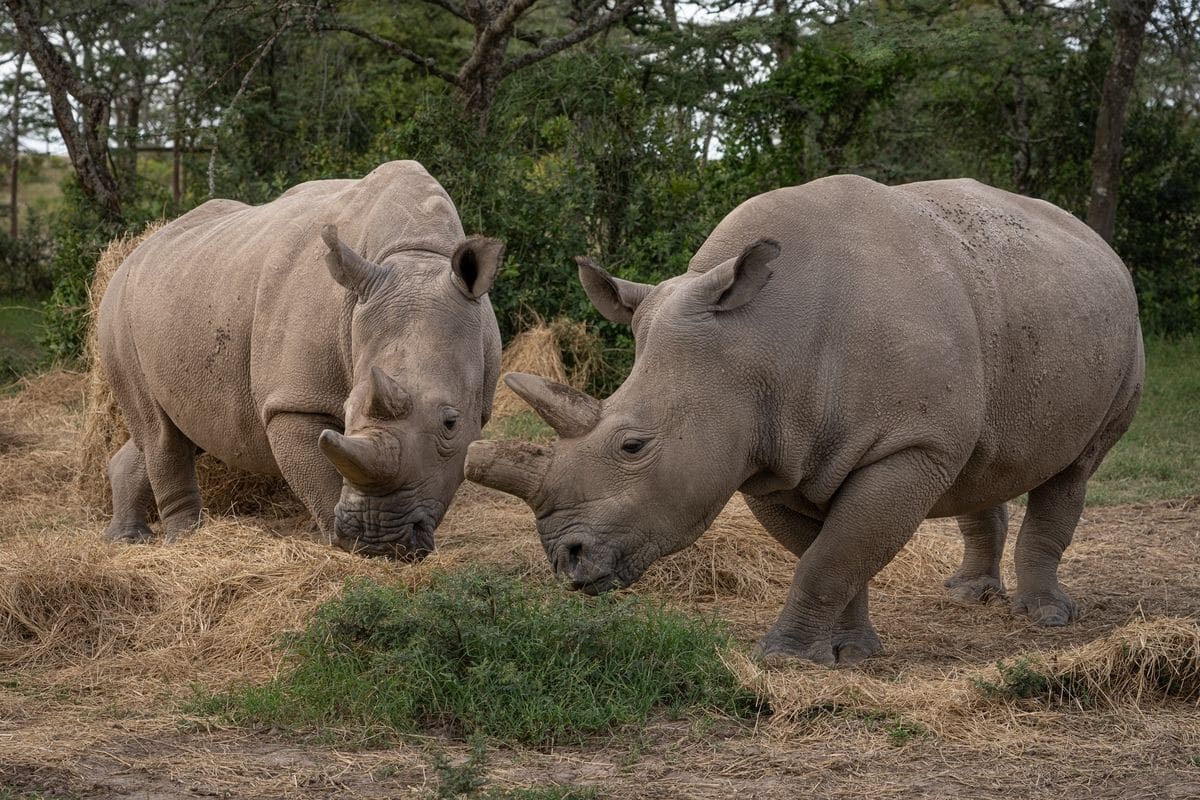

To keep the northern white rhinoceros from extinction, scientists are trying to make artificial eggs from stem cells. And that goal is now one step closer.
Fatu and Najin are the last two northern white rhinoceroses in the world. Because both are female – they are even mother and daughter – they can no longer reproduce naturally and extinction seems inevitable. However, scientists have been working against the clock for some time to ensure that this rhinoceros species does not disappear from our planet forever. While that is a particularly big challenge, they are now reporting that they are making progress. Because we have succeeded in generating so-called induced pluripotent stem cells – more on that later – from the northern white rhinoceros.
In the spring of 2018, the very last male northern white rhinoceros died. As a result, there are now only two females alive; Najin and Fatu; the last two northern white rhinoceroses to roam in the wild in Kenya. Since both are female, as mentioned, the line of northern white rhinoceroses really seems to end here. But researchers have devised a bold plan to save the species from extinction. For example, they want to try to save the northern white rhinoceros through IVF. Neither Najin nor Fatu are able to conceive due to health problems. As a result, the future of the northern white rhinoceros rests solely on artificial reproduction techniques. Several eggs have been harvested in recent years. Sperm from two deceased males were then injected into the oocytes. Fatu’s eggs were injected with Suni’s sperm, while Najin’s eggs were fertilized with Saut’s sperm. In the end, fourteen embryos were developed using Fatu’s eggs and the sperm of the deceased male. Unfortunately Najin’s eggs didn’t make it.
Thanks to artificial reproduction techniques (see box), 14 northern white rhinoceros embryos are now stored in ice-cold liquid nitrogen. In the near future, the embryos will be implanted into surrogate mothers of the southern white rhinoceros – a close relative – with the aim of delivering a healthy calf.
We’re not there yet
While this may be considered a great success, it is not enough to boost the northern white rhino population. “Because we couldn’t collect eggs from Najin, all fourteen embryos are from Fatu,” explains researcher Thomas Hildebrandt. “In addition, they are related and their genetic makeup is largely identical.” And so there is little diversity. “We urgently need an additional strategy to create eggs and sperm from significantly more specimens,” said Hildebrandt.
From skin cell to egg cell
So to ensure that the extinction of the northern white rhinoceros is not only delayed, but actually prevented, scientists are now studying whether it is possible to make artificial eggs from stem cells. This is a fairly complicated process, but in short it goes like this: one takes some skin tissue from the intended parent(s) and reprograms the skin cells in it into stem cells that can still go in all directions (the so-called induced pluripotent stem cells – abbreviated as iPSC). And you stimulate those stem cells – by adding various substances – to grow into an egg or sperm cell.
It’s possible!
While this may sound like science fiction, it has already been proven to be possible. In 2016, Japanese researchers managed to make eggs from a mouse’s tail, which were then fertilized via IVF. A short time later they were allowed to welcome a number of healthy mice.
Same trick
To do the same trick for the northern white rhinoceros, the researchers took some skin tissue, which they tried to convert into induced pluripotent stem cells. The first attempt unfortunately failed; the cells died. The researchers therefore introduced a gene that prevents cell death. And with that, they successfully obtained induced pluripotent stem cells from the northern white rhinoceros.

Stem cells in an undifferentiated state. In the top row, several signs of pluripotency are colored green. In the bottom row the cell nuclei are visible in blue. Image: AG Diecke, MDC
†Our study sheds new light on pluripotency – the ability of stem cells to differentiate into all cells of the body,” said researcher Vera Zywitza. “It therefore represents an important milestone on the road to artificially generated rhinoceros eggs.”
Next phase
However, the researchers are not yet able to proceed to the next phase; actually developing oocytes from the induced pluripotent stem cells. “The iPSC cells we cultured contain stubborn foreign genetic material,” explains Zywitza. “We are talking about the reprogramming factors and the gene that prevents cell death. This means that we cannot use them to make eggs because there is a risk that they will be pathologically modified.” Nevertheless, the cells developed are still extremely useful for studying rhinoceros stem cells in general and gaining a better understanding of their various states in particular. For example, the molecular mechanisms that take place in stem cells can now be investigated. “For example, we can study why the gestation period of a rhinoceros is 16 months and that of a mouse only 21 days,” Zywitza said. “We can also study how organs develop in different species. This teaches us a lot about evolution.”
So there is still a long way to go. But each step is one closer to the ultimate goal: saving the northern white rhinoceros. “Generating functional eggs from the northern white rhinoceros would be the culmination of our research,” said researcher Sebastian Diecke. This could then serve as a model for other endangered species. If stem cell reproduction works, the technique could be used to revive many more endangered or even extinct species. “The northern white rhinoceros would be just the beginning,” Dicke said. “Although of course it would be better if we never had to use our technique and we did more to conserve species before it’s too late.”
Source material:
†One step closer to artificial rhino eggs” – Max Delbruck Center for Molecular Medicine
Image at the top of this article: Jan Zwilling, BioRescue